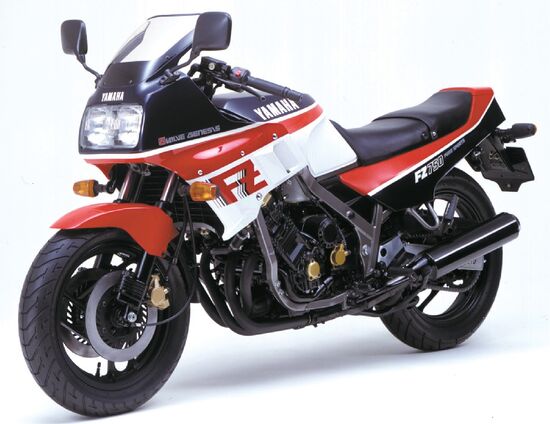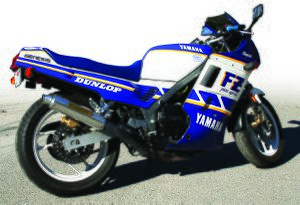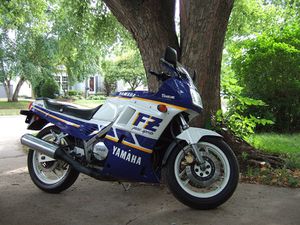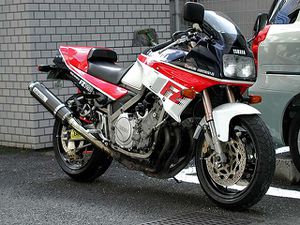Difference between revisions of "Yamaha FZ750"
m |
m |
||
| (5 intermediate revisions by the same user not shown) | |||
| Line 1: | Line 1: | ||
| − | {{DISPLAYTITLE:Yamaha FZ 750 Genesis | + | {{DISPLAYTITLE: Yamaha FZ 750 Genesis}} |
| − | |||
| − | |||
| − | |||
| − | }} | ||
__notoc__ | __notoc__ | ||
| − | + | [[file: Fz750_1985.jpg | 550px | center | Yamaha FZ 750 (1989-1991)]] | |
| − | + | The Yamaha FZ 750 Genesis was first introduced in 1985 and at the time had all of Yamaha's advanced technology. | |
| − | |||
| − | |||
| − | |||
| − | |||
{{Ads_top}} | {{Ads_top}} | ||
| − | + | The motorcycle competed well with all sports bikes of those years and was quite popular. This was due to the use of innovative technologies, such as - the forward-tilted 4-cylinder Genesis engine with a lowered center of gravity, which increased the handling of the motorcycle; the generator behind the block of cylinders (and not at the end of the crankshaft as on competitors), which made the motorcycle much narrower than competitors; Outstanding speed performance - the maximum claimed speed was about 150 mph (~ 241 km / h), which at that time was a very impressive result. | |
| + | |||
| + | The Yamaha FZ750 Genesis was based on an in-line 4-cylinder liquid-cooled engine with a volume of 749 cc. see, issuing from 100 to 110 hp. power (depending on the region of sale) and 80-81 Nm of torque. Maximum performance - at 8000-10000 rpm. | ||
| − | + | The frame of the motorcycle is tubular steel. The suspensions are simple, in the front there is a usual 39 mm telescopic fork, in the back there is a mono-shock absorber with a progression, adjustable in preload. The braking system of the Yamaha FZ750 changed depending on the year of manufacture - the most powerful brakes were on the motorcycle, since 1989 - 2 discs of 298 mm with 4-piston calipers. The total curb weight is 229-232 kg (depending on the year of manufacture). Fuel tank - 21-22 liters (depending on the year of manufacture). | |
| − | + | The Yamaha FZ750 Genesis model existed on the market until 1991 (inclusive), after which it was discontinued. The Yamaha FZ750 Genesis and [[Yamaha_FZR750 | Yamaha FZR750 Genesis]] left the market and were replaced in 1993 by the sports model [[Yamaha_YZF750 | Yamaha YZF750]]. Despite the fact that the Yamaha FZ750 was focused mainly on export to Europe and North America, there are currently a number of models presented at Japanese auctions. | |
| − | '' | + | '' The main competitors of the Yamaha FZ 750 in the class: '' |
| − | * [[Kawasaki_GPZ900|Kawasaki GPZ900R]] | + | * [[Kawasaki_GPZ900 | Kawasaki GPZ900R]] |
| − | * [[Suzuki_GSX750F_Katana|Suzuki GSX750F Katana]] ( | + | * [[Suzuki_GSX750F_Katana | Suzuki GSX750F Katana]] (1st generation) |
| − | == | + | == Photos == |
| − | {| border="0" | + | {| border = "0" |
| − | |[[Image:Web-Retro2.jpg| | + | | [[Image: Web-Retro2.jpg | 300px | thumb | right | Yamaha FZ 750]] |
| − | + | | [[Image: Aabec12e0b9dabea2e46dd56203c41c9.jpg | 300px | thumb | right | Yamaha FZ 750]] | |
| − | |[[Image:Aabec12e0b9dabea2e46dd56203c41c9.jpg| | + | | [[Image: 012.jpg | 300px | thumb | right | Yamaha FZ 750 (tuning)]] |
| − | |[[Image:012.jpg| | ||
|- | |- | ||
|} | |} | ||
| − | + | {{Ads_feed}} | |
{{Ads_post}} | {{Ads_post}} | ||
| − | == | + | == Specifications == |
| − | + | Specifications Yamaha FZ 750: | |
| − | {| class="wikitable" | + | {| class = "wikitable" |
| − | ! scope="row"| | + | ! scope = "row" | Model |
| − | |Yamaha FZ750 Genesis | + | | Yamaha FZ750 Genesis |
|- | |- | ||
| − | ! scope="row"| | + | ! scope = "row" | Motorcycle type |
| − | | | + | | sport |
|- | |- | ||
| − | ! scope="row"| | + | ! scope = "row" | Release year |
| − | |1985-1991 | + | | 1985-1991 |
|- | |- | ||
| − | ! scope="row"| | + | ! scope = "row" | Engine type |
| − | |4- | + | | 4-cylinder, 4-stroke, in-line |
|- | |- | ||
| − | ! scope="row"| | + | ! scope = "row" | Working volume |
| − | |749 | + | | 749 cc cm. |
|- | |- | ||
| − | ! scope="row"| | + | ! scope = "row" | Cooling |
| − | | | + | | liquid |
|- | |- | ||
| − | ! scope="row"| | + | ! scope = "row" | Bore / Stroke |
| − | |68 x 51 | + | | 68 x 51.6 mm |
|- | |- | ||
| − | ! scope="row"| | + | ! scope = "row" | Compression ratio |
| − | |11 | + | | 11.2: 1 |
|- | |- | ||
| − | ! scope="row"| | + | ! scope = "row" | Number of valves per cylinder |
| − | |5 | + | | 5 valves per cylinder, DOHC |
|- | |- | ||
| − | ! scope="row"| | + | ! scope = "row" | Fuel supply system |
| − | | | + | | carburetor, 4x Mikuni BDS34 |
|- | |- | ||
| − | ! scope="row"| | + | ! scope = "row" | Ignition type |
| − | |TCI | + | | TCI |
|- | |- | ||
| − | ! scope="row"| | + | ! scope = "row" | Maximum power |
| − | |110 | + | | 110 hp (81 kW) @ 10,500 rpm - FZ750 (North America) |
| − | 105 | + | 105 h.p. (77.4 kW) @ 10,500 rpm - FZ750 (England) |
| − | 101 | + | 101 h.p. (74.4 kW) @ 10,500 rpm - FZ750 (Europe) |
|- | |- | ||
| − | ! scope="row"| | + | ! scope = "row" | Maximum torque |
| − | |80 | + | | 80.0-81.4 Nm @ 8000 rpm |
|- | |- | ||
| − | ! scope="row"| | + | ! scope = "row" | Gearbox |
| − | |6- | + | | 6-speed |
|- | |- | ||
| − | ! scope="row"| | + | ! scope = "row" | Drive type |
| − | | | + | | chain |
|- | |- | ||
| − | ! scope="row"| | + | ! scope = "row" | Frame |
| − | | | + | | steel tubular |
|- | |- | ||
| − | ! scope="row"| | + | ! scope = "row" | Front suspension |
| − | | | + | | 39mm telescopic fork, 140mm travel |
|- | |- | ||
| − | ! scope="row"| | + | ! scope = "row" | Rear suspension |
| − | | | + | | linkage with monoshock, stroke - 120 mm (132 mm - since 1987) |
|- | |- | ||
| − | ! scope="row"| | + | ! scope = "row" | Front tire size |
| − | |120/80-V16 | + | | 120/80-V16 - FZ750 (1985-1988) |
| − | 120/70-V17 | + | 120/70-V17 - FZ750 (1989-1991) |
|- | |- | ||
| − | ! scope="row"| | + | ! scope = "row" | Rear tire size |
| − | |130/80-V18 | + | | 130/80-V18 - FZ750 (1985-1988) |
| − | 140/70-V18 | + | 140/70-V18 - FZ750 (1989-1991) |
|- | |- | ||
| − | ! scope="row"| | + | ! scope = "row" | Front brakes |
| − | |2 | + | | 2 discs, 235mm, 2-piston calipers - FZ750 (1985-1986) |
| − | 2 | + | 2 discs, 267 mm, 2-piston calipers - FZ750 (1987-1988) |
| − | 2 | + | 2 discs, 298mm, 4-piston calipers - FZ750 (1989-1991) |
|- | |- | ||
| − | ! scope="row"| | + | ! scope = "row" | Rear brakes |
| − | | | + | | Single disc, 235mm, 2-piston caliper - FZ750 (1985-1986) |
| − | + | Single disc, 267 mm, 2-piston caliper - FZ750 (1987-1991) | |
|- | |- | ||
| − | ! scope="row"| | + | ! scope = "row" | Dimensions |
| − | |2295 x 755 x 1165 | + | | 2295 x 755 x 1165 mm - FZ750 (1985-1986) |
| − | 2230 x 755 x 1200 | + | 2230 x 755 x 1200 mm - FZ750 (1987-1988) |
| − | 2235 x 755 x 1200 | + | 2235 x 755 x 1200 mm - FZ750 (1989-1991) |
|- | |- | ||
| − | ! scope="row"| | + | ! scope = "row" | Saddle height |
| − | |790 | + | | 790 mm - FZ750 (1985-1986) |
| − | 800 | + | 800 mm - FZ750 (1987-1991) |
|- | |- | ||
| − | ! scope="row"| | + | ! scope = "row" | Fuel tank capacity |
| − | |22 | + | | 22 L - FZ750 (1985-1986) |
| − | 21 | + | 21 L - FZ750 (1987-1991) |
|- | |- | ||
| − | ! scope="row"| | + | ! scope = "row" | Maximum speed |
| − | |241 | + | | 241 km / h |
|- | |- | ||
| − | ! scope="row"| | + | ! scope = "row" | Acceleration to 100 km / h |
| − | |3 | + | | 3.8 sec |
|- | |- | ||
| − | ! scope="row"| | + | ! scope = "row" | Motorcycle weight (curb) |
| − | |232 | + | | 232 kg - FZ750 (1985-1986), FZ750 (1989-1991) |
| − | 229 | + | 229 kg - FZ750 (1987-1988) |
| − | |||
| − | |||
| − | |||
| − | |||
| − | |||
| − | |||
| − | |||
| − | |||
| − | |||
|} | |} | ||
| − | == | + | == Documentation == |
| − | * [[Yamaha_FZ750:_manuals|Yamaha FZ750 | + | [[Category:Motorcycles]] |
| + | * [[Yamaha_FZ750:_manuals|Yamaha FZ750]] | ||
== == | == == | ||
{{Ads_recomended}} | {{Ads_recomended}} | ||
Latest revision as of 20:10, 15 August 2021
The Yamaha FZ 750 Genesis was first introduced in 1985 and at the time had all of Yamaha's advanced technology.
The motorcycle competed well with all sports bikes of those years and was quite popular. This was due to the use of innovative technologies, such as - the forward-tilted 4-cylinder Genesis engine with a lowered center of gravity, which increased the handling of the motorcycle; the generator behind the block of cylinders (and not at the end of the crankshaft as on competitors), which made the motorcycle much narrower than competitors; Outstanding speed performance - the maximum claimed speed was about 150 mph (~ 241 km / h), which at that time was a very impressive result.
The Yamaha FZ750 Genesis was based on an in-line 4-cylinder liquid-cooled engine with a volume of 749 cc. see, issuing from 100 to 110 hp. power (depending on the region of sale) and 80-81 Nm of torque. Maximum performance - at 8000-10000 rpm.
The frame of the motorcycle is tubular steel. The suspensions are simple, in the front there is a usual 39 mm telescopic fork, in the back there is a mono-shock absorber with a progression, adjustable in preload. The braking system of the Yamaha FZ750 changed depending on the year of manufacture - the most powerful brakes were on the motorcycle, since 1989 - 2 discs of 298 mm with 4-piston calipers. The total curb weight is 229-232 kg (depending on the year of manufacture). Fuel tank - 21-22 liters (depending on the year of manufacture).
The Yamaha FZ750 Genesis model existed on the market until 1991 (inclusive), after which it was discontinued. The Yamaha FZ750 Genesis and Yamaha FZR750 Genesis left the market and were replaced in 1993 by the sports model Yamaha YZF750. Despite the fact that the Yamaha FZ750 was focused mainly on export to Europe and North America, there are currently a number of models presented at Japanese auctions.
The main competitors of the Yamaha FZ 750 in the class:
- Kawasaki GPZ900R
- Suzuki GSX750F Katana (1st generation)
Photos
Specifications
Specifications Yamaha FZ 750:
| Model | Yamaha FZ750 Genesis |
|---|---|
| Motorcycle type | sport |
| Release year | 1985-1991 |
| Engine type | 4-cylinder, 4-stroke, in-line |
| Working volume | 749 cc cm. |
| Cooling | liquid |
| Bore / Stroke | 68 x 51.6 mm |
| Compression ratio | 11.2: 1 |
| Number of valves per cylinder | 5 valves per cylinder, DOHC |
| Fuel supply system | carburetor, 4x Mikuni BDS34 |
| Ignition type | TCI |
| Maximum power | 110 hp (81 kW) @ 10,500 rpm - FZ750 (North America)
105 h.p. (77.4 kW) @ 10,500 rpm - FZ750 (England) 101 h.p. (74.4 kW) @ 10,500 rpm - FZ750 (Europe) |
| Maximum torque | 80.0-81.4 Nm @ 8000 rpm |
| Gearbox | 6-speed |
| Drive type | chain |
| Frame | steel tubular |
| Front suspension | 39mm telescopic fork, 140mm travel |
| Rear suspension | linkage with monoshock, stroke - 120 mm (132 mm - since 1987) |
| Front tire size | 120/80-V16 - FZ750 (1985-1988)
120/70-V17 - FZ750 (1989-1991) |
| Rear tire size | 130/80-V18 - FZ750 (1985-1988)
140/70-V18 - FZ750 (1989-1991) |
| Front brakes | 2 discs, 235mm, 2-piston calipers - FZ750 (1985-1986)
2 discs, 267 mm, 2-piston calipers - FZ750 (1987-1988) 2 discs, 298mm, 4-piston calipers - FZ750 (1989-1991) |
| Rear brakes | Single disc, 235mm, 2-piston caliper - FZ750 (1985-1986)
Single disc, 267 mm, 2-piston caliper - FZ750 (1987-1991) |
| Dimensions | 2295 x 755 x 1165 mm - FZ750 (1985-1986)
2230 x 755 x 1200 mm - FZ750 (1987-1988) 2235 x 755 x 1200 mm - FZ750 (1989-1991) |
| Saddle height | 790 mm - FZ750 (1985-1986)
800 mm - FZ750 (1987-1991) |
| Fuel tank capacity | 22 L - FZ750 (1985-1986)
21 L - FZ750 (1987-1991) |
| Maximum speed | 241 km / h |
| Acceleration to 100 km / h | 3.8 sec |
| Motorcycle weight (curb) | 232 kg - FZ750 (1985-1986), FZ750 (1989-1991)
229 kg - FZ750 (1987-1988) |
Documentation



